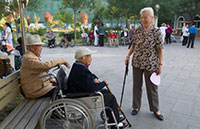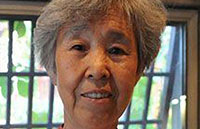Sun shines on Urumqi anti-pollution projects
By Shao Wei in Urumqi (China Daily) Updated: 2012-12-19 02:49One of China's most polluted cities in winter, Urumqi, has seen a massive improvement in its air quality, residents and experts said.
By Dec 10, the capital of the Xinjiang Uygur autonomous region had 279 "fairly good" days this year, three more than in 2011, according to the environmental protection agency.
"The sky is blue and the snow stays white, which was rare in Urumqi in the past. It's an amazing change," said Yuan Huixia, 51, as she did her morning exercises in a snow-covered park.
"Thick, black smoke used to cover the city throughout winter, even on sunny days. It was only on trips outside the city that we'd see clear skies and realize it's a sunny day," she said.
The fresher air has also led to a decrease in the number of patients who are in hospitals with respiratory problems this winter, data suggest.
In November, 1,983 people were seen at the outpatient department of the People's Hospital of the Xinjiang Uygur Autonomous Region for respiratory problems, compared with 2,711 in the same month last year.
"Heavy smog has always triggered respiratory trouble for people in winter. The improved air quality this winter is the main reason for the decrease," said Qiao Lipan, director of respiratory medicine at Urumqi Children's Hospital.
The improved air quality is the result of the city government's massive investment in March in 16 projects, including a large overhaul of the city's heating system — especially the demolition of 5,000 small coal-firing furnaces for winter heating — and improving air emissions treatment at 30 big polluting factories.
The gas-powered heating system now covers 76 percent of the city's population, massively cutting its reliance on coal.
Natural gas is cleaner than coal and can greatly reduce sulfur dioxide and soot emissions, said Parida Yakup at Xinjiang Agricultural University, who has studied air pollution controls for more than 20 years.
"The city started a 'Blue Sky Project' in 1998 to deal with severe air pollution. However, only this year did Urumqi residents begin to see the effects," she said. "You see, the color of sparrows has turned from black to normal."
Air pollution has been a persistent headache for the city over the past decade. Pollution levels in the winter are almost double those in summer, largely because of heating system emissions.
The Xinjiang capital, in a river valley and surrounded by mountains, has difficulties with atmospheric dispersion and dilution in wintertime. The long heating period, October to April, generates tons of sulfur dioxide and soot, blanketing the city in a heavy haze in the winter.
In an assessment of national environmental protection and pollution control in 2007, the city was rated "substandard" for its air pollution in winter.
"In the past decade, to cut air pollution, the city demolished small furnaces, built large furnaces for concentrated heating, and increased the height of chimneys," Parida Yakup said. "However, such efforts could not solve the air pollution. The waste gas and soot were emitted into a higher layer of the atmosphere, but still in Urumqi."
She also expressed concern over the use of natural gas as a main heating resource.
"The large-scale use of natural gas has brought us more blue-sky days, but it cannot solve the problem alone," she said.
Rui Lihong, chief engineer of the Urumqi environmental protection agency, agreed and added that, as Xinjiang has rich coal resources that cost far less than natural gas, factories are reluctant to switch.
Moreover, she added, the greatest cause of Urumqi's air pollution has changed from coal-fired heating to vehicle emissions.
More than 500,000 vehicles are registered in the city, up from 400,000 in August 2011, and the number keeps rising, according to the public security bureau.
Contact the writer at shaowei@chinadaily.com.cn
- Jobs growing, but applicants are lagging
- Top Chinese economic fugitive to return
- Taiwan investigators detect 'gasoline reaction'
- Government moves to tackle e-waste pollution
- Xi calls for heightened supervision of reform
- Authorities working on plan to delay retirements
- Airlines' obligations clarified
- Delayed retirement to be rolled out slowly
- Xi orders China's developed east to better aid poor west
- Short-circuit blamed for catastrophic tour bus fire










